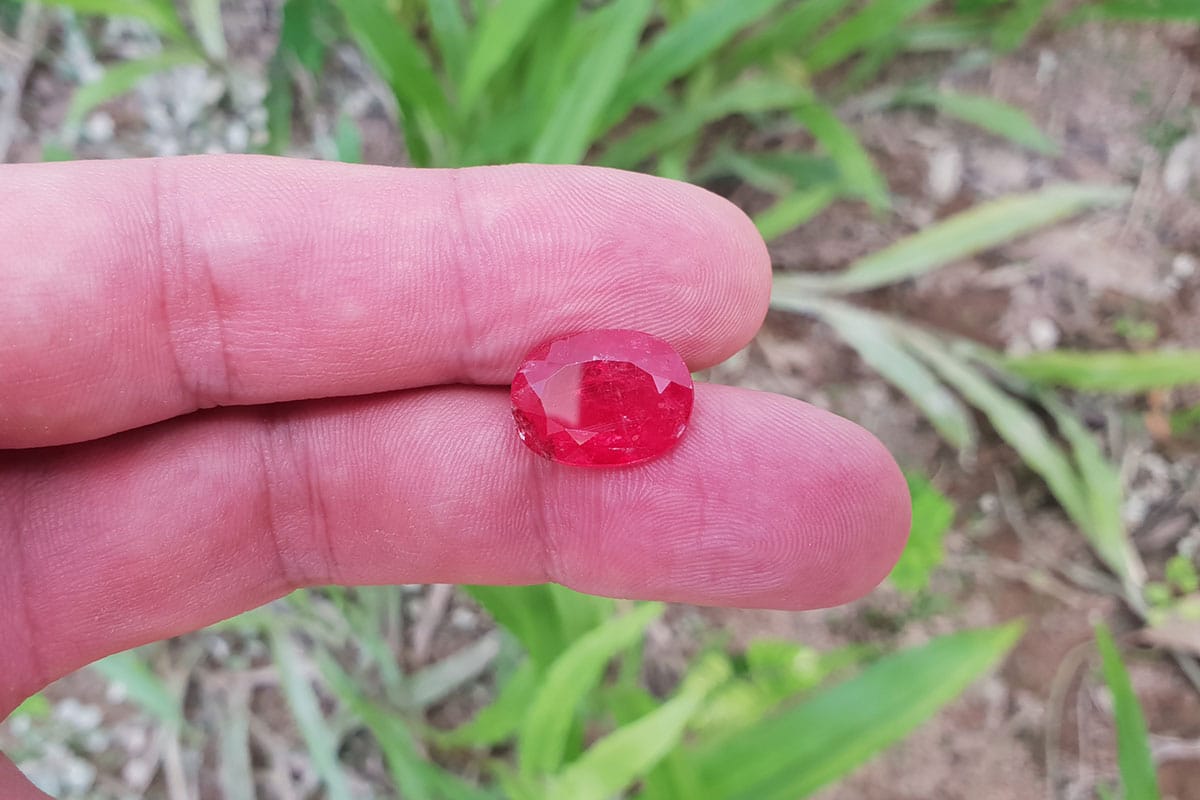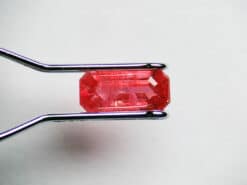Rhodonite

Buy natural rhodonite in our shop
Rhodonite Meaning
It is a manganese inosilicate mineral, chemically classified as (Mn, Fe, Mg, Ca)SiO3. It belongs to the pyroxenoid group and crystallizes in the triclinic crystal system. Typically found in cleavable to compact masses, rhodonite is known for its rose-red to pink hues. Over time, surface oxidation can cause certain areas to darken, lending a subtle brownish tint that offers an intriguing contrast to its naturally vibrant coloration. The name rhodonite is derived from the Greek rhodos, meaning “rosy,” which directly references its characteristic hue.
Well-formed rhodonite crystals are rather rare. More commonly, this stone is discovered as massive aggregates or in tabular crystals that show perfect prismatic cleavage, nearly at right angles. Its hardness ranges from about 5.5 to 6.5 on the Mohs scale, rendering it sufficiently durable for use in jewelry or ornamental pieces. The mineral’s luster is generally vitreous, though in some instances it can appear slightly pearly on certain cleavage surfaces. Its specific gravity lies between 3.4 and 3.7, reflecting a relatively dense composition.
In rhodonite, manganese frequently serves as the principal cation, but partial substitution by iron, magnesium, or calcium is not uncommon. In some specimens, zinc may also be present in notable amounts, subtly influencing the stone’s color and internal structure. For example, a grayish-brown variety containing around 20% calcium oxide is known as bustamite. Another variety, fowlerite, incorporates about 7% zinc oxide. Such compositional variations highlight rhodonite’s mineralogical complexity and underscore its adaptability within different geological environments.
Beyond its chemical and crystallographic features, The gemstone is appreciated for its attractive coloration and the distinctive presence of darker manganese oxide veins. These contrast-rich patterns enhance the stone’s aesthetic appeal, making it a sought-after material for gemstone collectors and jewelry enthusiasts. When polished, rhodonite reveals a gorgeous interplay of warm pink and deep brownish-black elements, often carved into cabochons, beads, or sculptural forms that accentuate its natural beauty.
Inosilicate Structure
The gelmestone is categorized as an inosilicate, or chain silicate. In such minerals, the silica tetrahedra are linked in chains, with rhodonite’s crystal structure characterized by a repeat unit of five silica tetrahedra. This arrangement imparts distinctive physical and optical properties. A closely related but rarer polymorph known as pyroxmangite shares the same chemical composition as rhodonite but forms under different pressure and temperature regimes. Pyroxmangite displays a slightly different structure, with a repeat unit of seven silica tetrahedra, illustrating how subtle changes in crystallographic organization can yield distinct mineral forms.
Due to its appealing color and patterning, the stone has historically been used as an ornamental stone. It has been found in the iron and manganese mines of Pajsberg near Filipstad and Långban in Värmland, Sweden, where translucent to semi-translucent crystals, sometimes referred to as pajsbergite, have been unearthed. These occurrences are notable not only for their aesthetic value but also for the insights they provide into the geological processes that contribute to rhodonite’s formation.
Fowlerite, the zinc-bearing variety of rhodonite, often appears as large, somewhat blocky crystals that can be visually mistaken for pink feldspar at first glance. Significant deposits of fowlerite, along with franklinite and zinc ores, are found embedded in granular limestone at Franklin Furnace in New Jersey, USA. Such localities are crucial for mineralogists and geologists studying the conditions that give rise to these diverse mineral assemblages, and they highlight the adaptability of rhodonite’s crystal chemistry within various geological contexts.
Pyroxenoid Group
It is part of the pyroxenoid group, which includes minerals that are structurally similar to, but distinct from, the pyroxene group. These chain silicates constitute a large portion of Earth’s crust, with silicate minerals in general making up about 90% of all rock-forming minerals. Silicon dioxide (SiO2), or silica, is fundamental to this family. Even though pure silica manifests in mineral form as quartz and its polymorphs, its incorporation into complex frameworks like that of rhodonite reflects the vast structural and compositional diversity seen in the mineral kingdom.
As a rock-forming mineral within certain geologic settings, rhodonite provides valuable clues about the temperature, pressure, and chemical conditions prevalent during its formation. Variations in elemental substitutions, the presence of impurities, and subsequent oxidation or alteration processes all shape the stone’s appearance and quality. By studying rhodonite and its related minerals, scientists gain a deeper understanding of the geological forces that mold our planet’s crust, as well as the environmental factors influencing mineral genesis over time.
Rhodonite Crystal Meaning and Healing Properties
The following section is pseudo-scientific and based on cultural beliefs rather than established scientific evidence.
In various metaphysical and holistic traditions, rhodonite is regarded as a stone of compassion, self-discovery, and emotional equilibrium. Proponents of these beliefs suggest that gemstone helps heal emotional wounds and past traumas, nurturing love, empathy, and forgiveness. It is often said to resonate with the heart chakra, stimulating and clearing stagnant energies while encouraging personal growth. It’s symbolic grounding properties are thought to aid in achieving balance, helping individuals align their inner energies to better realize their highest potential.
Some practitioners believe that placing or wearing rhodonite may help alleviate emotional shock, panic, and anxiety, providing a calming presence in turbulent times. Its soothing energy, according to these interpretations, encourages patience, confidence, and personal empowerment. While these claims are not supported by scientific research, many find comfort and inspiration in the stone’s gentle aura and the symbolic messages it is believed to carry.
FAQ
What chakra is rhodonite good for?
Rhodonite is commonly associated with the heart chakra. Practitioners believe it helps balance emotional energy, calm impatience, and support the healing of emotional wounds. By resonating with this energy center, it may encourage love, compassion, and understanding in relationships.
Where should I put rhodonite stone in my house?
Some traditions recommend placing rhodonite in the southern area of a home or living space, an area often linked to fame, reputation, and personal growth. By positioning the stone in this region, it’s thought to help strengthen one’s standing in the community and enhance overall harmony within the household.
Can you sleep with rhodonite?
Many believe that sleeping with rhodonite under your pillow allows its energies to work more deeply within your subconscious. As you release the need for control during sleep, the stone’s purported nurturing and soothing qualities may encourage meaningful dreams, emotional insights, and a more restful night.
What crystals work well with rhodonite?
It is said to harmonize well with other heart-centered stones like rose quartz and emerald. Combining these stones is believed to amplify their collective healing and supportive properties. Additionally, pairing the gemstone with garnet is thought to support the achievement of personal ambitions and life goals.
Can I wash rhodonite?
To clean rhodonite, avoid ultrasonic or steam cleaners, as these methods could fracture the stone. Instead, gently wash it with warm soapy water and a soft cloth. Rinse thoroughly and pat dry. To prevent scratching, store the stone separately from other gemstones or jewelry pieces.


